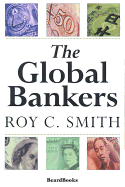|
|
|
|
||||||

|
The Global Bankers
By Roy C. Smith 2000/08 - Beard Books 1587980223 - Paperback - Reprint - 413 pp. US$34.95 An interesting and illuminating perspective on global banking as it was carried out on the eve of the 1990s from its three continental centers: New York, London, and Tokyo. Publisher Comments
An interesting and illuminating perspective on global banking as it was carried out on the eve of the 1990s from its three continental centers: New York, London, and Tokyo, The Global Bankers deals with each of these regions separately, tracing the international development of the markets and highlighting the principal distinctions and the most important and topical features of each. It examines innovative developments in European finance beginning with the rise of the Eurobond market and including the free-market reconstruction of the London stock exchange and the surprising resurgence of pragmatic capitalism in socialistic Europe. Focus is also given to the internationalization of finance in the United States and the financial ways of the wily Japanese. Review by Gail Owens Hoelscher The Global Bankers is a fascinating book that examines global banking activities as they were carried out on the eve of the 1990s from its three major centers: New York, London, and Tokyo. The author, Roy C. Smith, says his goal in writing the book was to "identify who all these busy people are who practice global banking today and what it is that they do." He is one of those busy people himself, having been a partner at Goldman, Sachs before moving to academia. First published in 1989, The Global Bankers discusses the banking systems of the U.S., Europe, and Tokyo separately, but always underscoring their interconnectedness. Mr. Smith traces the international development of the markets and highlights the principal distinctions and most important and topical features of each. Throughout the book, Mr. Smith introduces terms and definitions for the reader new to the field, but never in a condescending way. (He includes a useful glossary as well.) The introduction looks at the global banking system from the point of view of a fictitious but astute U.S. businessman who discovers how the globalization of banking has extended the range of opportunities available to him. "George" learns all about merchant banks, banques d'affaires, clearing banks, junk bonds, and collateralized mortgage obligations. The greater part of the book is made up of four sections entitled "The Internationalization of American Finance," "Crusades in European Finance," "The Floating World of Japanese Finance," with a final chapter called "Looking to the Millenium." Mr. Smith shows how the initial impetus to the tremendous growth of financial assets and instruments of the late 20th century was the burgeoning balance-of-payment deficits incurred by the U.S. after World War II. Once the U.S. halted sales of gold reserves to foreign dollar-holders and the fixed-rate foreign-exchange system was abandoned for a floating system, financial deregulation occurred in many countries, and financial resources flowed to attractive opportunities worldwide. The next big challenge took the form of high oil prices, and in 1979 the U.S. Federal Reserve instituted money-supply controls, with consequential high interest rates and acute volatility in the markets for financial instruments and foreign exchange. The 1980s heralded the era of the institutional investor/trader, a financial boom, and then October 19, 1987, when markets crashed in New York, London, Frankfurt, Zurich, Sydney, Tokyo, and Hong Kong. Much of the chapter on the U.S. is devoted to these events. Mr. Smith also examines innovative developments in European finance during this same period, beginning with the rise of the Eurobond market and including the free-market reconstruction of the London Stock Exchange and the surprising resurgence of pragmatic capitalism in socialist-leaning Europe. He then attempts to demystify the financial customs of the Japanese, and stresses the interdependence of the U.S. and Japan. Mr. Smith closes by identifying some trends and "megatrends," and with some predictions and admonitions for the subsequent decade, the 1990s. He was right on target with some of these, and some go far toward explaining what is happening in the markets right now. From Publisher's Weekly: From Publisher's Weekly: This balanced, instructive and readable narrative both records and projects a new financial era. In worldwide perspective, Smith, who teaches finance at New York University, analyzes Japan's major investment in U.S. industry, London's huge bond market in ``Eurodollars'' free of regulation, Germany's potentially dominant role in a tariff-less Europe after 1992, the massive Third World debt's impact on American bank earnings and foreign involvement in Wall Street's high-stakes mergers and acquisitions. ``The financial industry simply cannot escape the consequences of globalization,'' the author convincingly declares. Smith is particularly enlightening on the Japanese ethic and related bargaining methods in his depiction of Goldman Sachs, where he was a partner, negotiating a deal for international operations with Tokyo's Sumitomo Bank. (Oct.) From Library Journal: This book provides an insider's view of the rapidly evolving integration of the world's financial markets. The author formerly worked for Goldman Sachs and now teaches international banking and finance at NYU. Given the freer trade measures to be enacted in 1992 in the European Common Market, his book is on a timely and important subject. However, the first half of the book has too many technicalities and too much jargon. The second half of the book does better in providing some historical perspective. Still, the major trends and motivations that fuel international finance remain somewhat obscured after reading this book. Most libraries will find that general books on international finance and banking will cover this subject more successfully.-- Richard C. Schiming, Mankato State Univ., Minn.
|
|
|
|
home
| about us
| contact us
| related
sites |